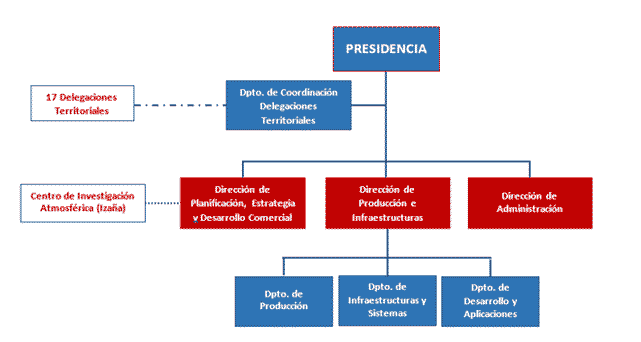Organization
The Izaña Atmospheric Research Center IARC is part of the Department of Planning, Strategy and Business Development of the State Meteorological Agency of Spain AEMET. AEMET is an Agency of the Spanish Ministry for the Ecological Transition and Demographic Challenge. (MITECO)

Organization chart
Mission and Background
The Izaña Atmospheric Research Center conducts observations and research related to atmospheric constituents that are capable of forcing change in the climate of the Earth (greenhouse gases and aerosols), and may cause depletion of the global ozone layer, and play key roles in air quality from local to global scales. The IARC is an Associated Unit of the Spanish National Research Council (CSIC) through the Institute of Environmental Assessment and Water Research (IDAEA). The main goal of the Associated Unit “Group for Atmospheric Pollution Studies” is to perform atmospheric air quality research in both rural and urban environments.
The IARC has contributed to the World Meteorological Organization (WMO) Global Atmosphere Watch (GAW) Programme since its establishment in 1989. The GAW Programme marked its 30th anniversary this year. GAW integrates a number of WMO research and monitoring activities in the field of atmospheric environment. The main objective of GAW is to provide data and other information on the chemical composition and related physical characteristics of the atmosphere and their trends.These are required to improve our understanding of the behaviour of the atmosphere and its interactions with the oceans and the biosphere.
The Izaña Atmospheric Research Center also contributes to the Network for the Detection of Atmospheric Composition Change (NDACC). NDACC is an international network for monitoring atmospheric composition using remote measurement techniques. Originally, NDACC was created to monitor the physical and chemical changes in the stratosphere, with special emphasis on the evolution of the ozone layer and the substances responsible for its destruction known as Ozone Depleting Substances. The current objectives of NDACC are to observe and to understand the physicochemical processes of the upper troposphere and stratosphere, and their interactions, and to detect long-term trends of atmospheric composition. IARC also makes an important contribution to the WMO through the Global Climate Observing System and through the Commission for Instruments and Methods of Observation (CIMO) as a WMO-CIMO Testbed for Aerosols and Water Vapour Remote Sensing Instruments.
Izaña Atmospheric Observatory was inaugurated in its present location on 1 January 1916, initiating uninterrupted meteorological and climatological observations, which constituted a 103-year record in 2018. In 1984, the observatory became a station of the WMO Background Atmospheric Pollution Monitoring Network (BAPMoN). In 1989, BAPMoN and GO3OS (Global Ozone Observing System) merged in the current Global Atmosphere Watch Programme, of which Izaña Atmospheric Observatory is one of 31 GAW Global stations (Figure 2.1). GAW Global stations serve as centres of excellence and perform extensive research on atmospheric composition change.
Izaña Atmospheric Observatory is a key example of such a research facility.

WMO GAW Global stations
